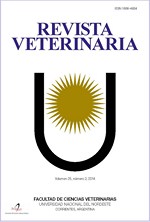Identification of gastrointestinal nematodes in working equines of brick makers of Gobernador Virasoro, Corrientes (Argentina)
DOI:
https://doi.org/10.30972/vet.3517477Keywords:
horses, gastrointestinal helminths, prevalence, parasitic loadAbstract
Gastrointestinal parasitism is very common in horses in northeastern Argentina, where it is often subclinical, leading to losses in body development and reduced animal performance. The objective of this study was to characterize the population of gastrointestinal nematodes in horses from the town of Gobernador Virasoro, Corrientes, used in the artisanal production of bricks. An observational cross-sectional descriptive study design was used and non-probability convenience sampling was performed. The number of eggs per gram of feces was determined by coprological examinations (modified McMaster technique), and all samples with the presence of gastrointestinal nematode eggs were considered positive. Morphologically, eggs of the order Strongylida were distinguished from eggs of Parascaris equorum and Oxyuris equi and the possible combinations between them. Parasitic genera of the order Strongylida were identified from pool coprocultures, differentiating between large and small strongyles. The results showed that 94.79% of the samples were positive, of which 83.43% corresponded to the order Strongylida only, 10.98% to the combination with eggs of P. equorum and 5.59% to the combination with eggs of O. equi. The highest average number of eggs belonged to the Strongylida order, with 90.55% corresponding to small strongyles. The results of this study suggest that gastrointestinal parasitism is a major problem in the working horse population of Gobernador Virasoro and could have a negative impact on animal health and performance.
Downloads
References
Alegre R, Milano F. Helmintos y protozoos gastrointestinales en equinos de Corrientes, Argentina. Rev. Vet. 2020; 31(1): 85-88.
Anziani OS, Cooper LG, Cerutti J, Fassola L, Torrents J, Masnyj F, Caffe G. Pequeños estróngilos de los equinos: Eficacia clínica y periodo de reaparición de huevos luego del tratamiento con moxidectina y pirantel. Rev. FAVE. Sección Ciencias veterinarias. 2017; 16(2): 83-87.
Bullman MG. Pérdidas económicas directas e indirectas por parásitos internos y externos de los animales domésticos en Argentina. Anales de la Academia Nacional de Agronomía y Veterinaria. 2012. tomo LXVI. Buenos Aires. Argentina. ISSN 0327-8093. p. 76-176. Disponible en http://hdl.handle.net/10915/32935
Corticelli B, Lai M. Studies on the technique of culture of infective larvae of gastrointestinal strongyles of cattle. Acta Med. Vet. Napoli. 1963; 9: 347-357.
Fiel CA, Steffan P, Ferreyra D. Diagnóstico de las parasitosis más frecuentes en rumiantes: Técnicas de laboratorio e interpretación de resultados. Ed: Área de Parasitología FCV-UNCPBA y Pfizer Sanidad animal. 2011; 131 p. ISBN 978-987-33-1502-2.
Fusé L, Saumell C, Iglesias L. Variación estacional del parasitismo interno en equinos: fenómeno de hipobiosis de los pequeños estróngilos (Cyathostominae) en Tandil, Buenos Aires, Argentina. Rev. Med. Vet. 2013; 3: 62-72.
Lamberti R, Gino LM, Macaró GPB, Benito AD. Epidemiología y parasitismo gastrointestinal en equinos del departamento Maracó, provincia de La Pampa, República Argentina. Ciencia Veterinaria. 2008; 10(1): 32-36.
Love S, Murphy D, Mellor D. Pathogenicity of cyathostome infection. Vet Parasitol. 1999; 85: 113-120.
Roberts FH, O’Sullivan PJ. Methods for egg counts and larvae cultures for strongyles infesting the gastro-intestinal tract of cattle. Rev. Austr. J. Agr. 1949; 1: 99-102.
Rosa A, Ribicich M. 2012. Parasitología y enfermedades parasitarias en veterinaria. Editorial Hemisferio Sur. 2012; ISBN 978-950-504-618-8.
Salas Romero J, Villavicencio L, Camejo BB, Ponce JDM, Llorens YG, Tobar AM. Prevalencia de las helmintiasis gastrointestinales equinas en el rancho San Vicente, provincia Camagüey. Rev. Prod. An. 2009; 20(1): 63-67.
Soulsby EJL. 1987. Parasitología y enfermedades parasitarias en los animales domésticos. 7a ed. México: Interamericana. 1987; ISBN 968-25-7371-5.
Tedla M, Abichu B. Cross-sectional study on gastro-intestinal parasites of equids in South-western Ethiopia. Par. Epid. and control. 2018; 3(4): e00076. doi:10.1016/j.parepi.2018.e00076
Thienpont D, Rochette F, Vanparij OFJ. Diagnóstico de las helmintiasis por medio del examen coprológico. Janssen Res. Found. 1979; 617 Beerse, Bélgica. 187 p.
von Samson-Himmelstjerna. Anthelmintic resistance in equine parasites-detection, potential clinical relevance and implications for control. Vet. Parasitol. 2012; 185: 2-8.
Downloads
Published
How to Cite
Issue
Section
License

This work is licensed under a Creative Commons Attribution-NonCommercial 4.0 International License.
Revista Veterinaria (Rev. Vet.) maintains a commitment to the policies of Open Access to scientific information, as it considers that both scientific publications as well as research investigations funded by public resources should circulate freely without restrictions. Revista Veterinaria (Rev. Vet.) ratifies the Open Access model in which scientific publications are made freely available at no cost online.











.jpg)
.jpg)



